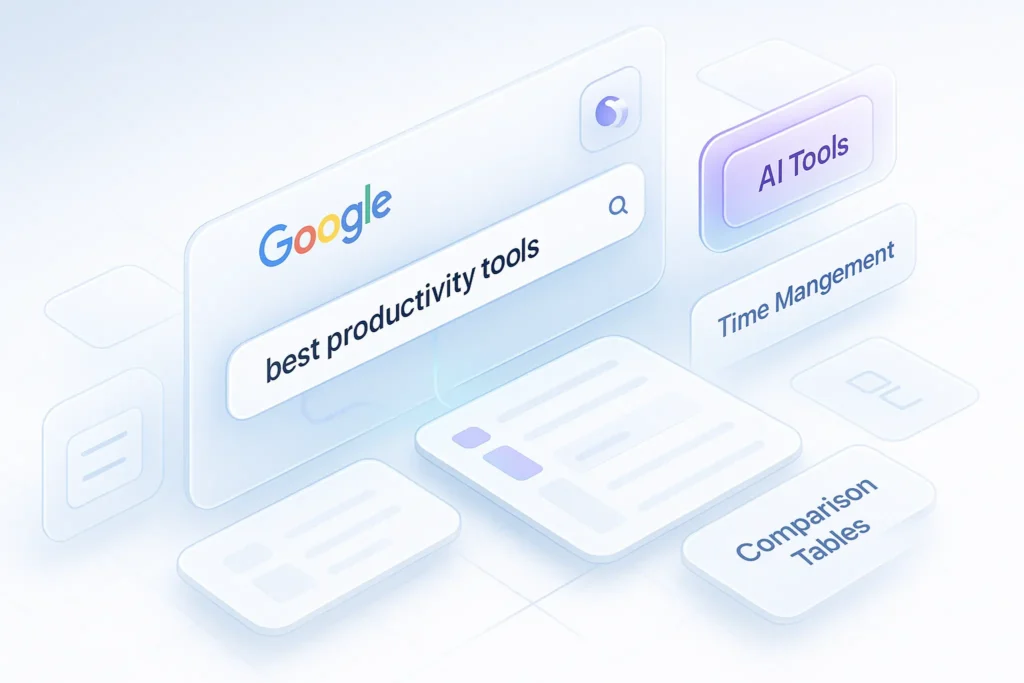🧠 Introduction: From Keywords to Intent—Search Is Evolving
Google Search is quietly undergoing one of its biggest transformations yet.
With the rollout of a new experimental feature called Web Guide, Google is no longer just listing links—it’s interpreting your search intent and clustering results accordingly. Powered by a customized version of Gemini AI, Web Guide breaks your query into multiple sub-intents, performs parallel micro-searches, and organizes the results into meaningful categories.
This isn’t just an interface change. It’s a paradigm shift in how information is retrieved, ranked, and presented.
And for content creators, SEOs, and marketers, it brings a new set of challenges—and opportunities.
Let’s unpack how Web Guide works, how to test it today, and what it means for the future of search
If you’re tracking how search is evolving, don’t miss our in-depth writeup on Google’s Gemini AI, which powers the very core of Web Guide’s logic.
🔍 How Does Google Web Guide Work?
Web Guide is currently available in Google’s Search Labs, and only for select users (primarily in the U.S.) who opt into the experiment. Once activated, it modifies the “Web” tab results and restructures them using AI-generated clusters based on search intent—not just keywords.
🔧 Here’s what it actually does:
-
Intent Decomposition
Google uses Gemini AI to break your query into multiple possible sub-intents or interpretations.E.g. searching “best laptops for remote work” might yield:
-
Productivity-focused laptops
-
Lightweight laptops for travel
-
Laptops with long battery life
-
Expert recommendations
-
-
Multi-Threaded Search Execution
Each intent triggers a parallel query and content retrieval task. It’s like doing 5 Google searches at once—without realizing it. -
AI-Powered Grouping & Labeling
Results are grouped under expandable headers like:-
“Top Picks from Experts”
-
“What People Ask”
-
“Comparison Guides”
-
“Productivity Devices for Travel”
-
-
New UI Structure
The Web tab presents results inside collapsible cards, similar to a research guide or curated topic feed. This feels more interactive—and less scroll-fatiguing—than a flat list of blue links.
📬 Want More SEO & Search Trends Like This?
Join our free newsletter to get exclusive insights on AI-powered search, no-code tools, and the evolving SEO landscape—delivered every week.
🧪 What’s It Like to Use?
-
✅ Easier to scan & compare results
-
✅ Prioritized user intent, not just link authority
-
✅ Highlights long-form, high-context content over keyword-stuffed pages
-
❌ Slightly slower to load due to AI clustering
-
❌ Not great for quick, navigational queries
Web Guide isn’t replacing traditional results—yet. But it augments them in ways that suggest where search might be headed.
Also, for marketers trying to keep up with this AI shift, our post on Top SEO Tools and How They’ve Evolved breaks down how SERP optimization must now include behavioral and intent analysis—not just backlink hunting
📉 What Does Web Guide Mean for SEO?
The shift from keyword-first to intent-first search results changes the game for SEOs and content creators. Here’s how:
🎯 1. Ranking Is Now Multi-Dimensional
In Web Guide, your content may appear in one or more clusters depending on how well it aligns with different user intents. It’s no longer about ranking “position 3″—it’s about being:
-
📌 Selected in the “Expert Picks” group
-
💬 Featured in the “People Also Ask” cluster
-
📚 Shown in a “Comparison Guide” section
Each of these clusters behaves like a micro-SERP, with its own layout and click behavior.
📉 2. CTR Will Fragment
Since results are organized by semantic category, the traditional “top 10 blue links” structure is diluted. That means:
-
Some users may expand only one cluster, skipping others entirely
-
The first link is no longer always the most-clicked
-
Visual priority (titles, formatting, structured content) now matters more than numerical position
📑 3. Long-Tail, Informational Content Gets a Boost
Google seems to reward content that:
-
Answers multiple facets of a query
-
Covers variations of user intent (guide, comparison, opinion)
-
Uses semantic structuring (FAQ blocks, subheaders, tables, etc.)
Thin affiliate pages and content with shallow keyword targeting may suffer under this new structure.
And if you’re a content creator wondering whether AI will help or hurt your traffic, our guide AI Writing Tools: Do They Really Help? walks through pros, cons, and future workflows.
🧠 Strategy Shift: SEO Is Now Intent Engineering
Writers and SEOs must now optimize not just for a keyword—but for the range of intents behind it.
Let’s take “best standing desks”:
-
Some users want comparisons
-
Others want ergonomic tips
-
Some are looking for home office setups under $200
-
Others want expert picks or Reddit-style opinions
To win, your content should now address more than one of these angles, using clear formatting and structured markup.
🧠 Nerd Tip: Search is no longer a race to the top—it’s a game of matching what the user really wants.
🛠 Tools & Tactics to Align with Web Guide
To adapt to this new AI-powered, intent-grouped search environment, SEOs and content strategists need more than just keywords and backlinks. Here are modern tactics to future-proof your content:
🧩 1. Use SERP Analysis Tools That Detect Intent Clusters
Most traditional keyword tools (like Ubersuggest) only show search volume. Instead, tools like:
-
AlsoAsked
-
Keyword Insights
-
Surfer SEO
-
Frase.io
…can help analyze search behavior and intent splits, giving you a map of how users are thinking—not just searching.
📐 2. Structure Content with Semantic Anchors
Make it easier for Google to extract and group your content by using:
-
✅ H2/H3 subheadings for each user intent
-
✅ FAQ blocks with natural questions
-
✅ Feature tables and comparison blocks
-
✅ Internal jump links to improve UX and crawlers’ understanding
Tip: Even a well-written paragraph like the one you’re reading now may live in a “summary” card under a future Web Guide result.
🎯 3. Optimize for Multiple Micro-Intents
Instead of writing 10 separate posts for slight keyword variations, consider consolidating and structuring your content to reflect:
-
“What is…”
-
“How to…”
-
“Best tools for…”
-
“Expert opinions on…”
This approach increases your SERP surface area—allowing you to appear in more than one result cluster.
⚠️ Risks and Opportunities for SEOs and Marketers
❌ Threats:
-
Keyword cannibalization matters less than intent dilution
-
Old-school SEO tricks (stuffing, exact-match domains, thin landing pages) lose value
-
Brand visibility may suffer if not optimized for visual formatting and content grouping
✅ Opportunities:
-
Quality, rich content has a chance to appear multiple times
-
Niche blogs can win intent clusters with fewer backlinks
-
Content hubs and E-E-A-T signals may be amplified inside category cards
🧠 Bottom line? Web Guide rewards those who understand behavior, not just algorithms.
🕰️ Timeline: Evolution of Google Search – From Links to Intent
Understanding Google Web Guide requires context. Here’s how Google’s approach to ranking and organizing content has evolved over time:
| Year | Milestone | Impact |
|---|---|---|
| 2001–2009 | 10 Blue Links | Simple keyword matches + link authority ruled |
| 2012 | Hummingbird | First semantic-based update—query meaning mattered more |
| 2015 | RankBrain | Machine learning model enhanced personalization & context |
| 2019 | BERT | Sentence-level understanding + better handling of nuance |
| 2023 | SGE Preview | Generative AI answers began showing in top SERPs |
| 2025 | Web Guide (Labs) | Gemini AI now organizes results by user intent clusters |
🧠 Insight: Google is no longer finding results—it’s guiding journeys.
🧠 Bonus: How to Structure Content for Web Guide’s Intent Clusters
If you want your article to appear in multiple categories inside a Web Guide result, use this framework:
🧩 Multi-Intent SEO Framework
-
Map Your Keyword to 3+ Search Intents
→ e.g., For “Best AI Writing Tools”:-
Tool comparison
-
Beginner-friendly options
-
Expert reviews
-
Use-case specific guides (e.g. blogging, marketing)
-
-
Assign Clear H2s for Each
Google clusters content by structure. Use H2 headers that mirror user queries. -
Add Summarizable Elements
Use bullet points, short intros, and bolded highlights to help Google extract summaries. -
Use Visual Aids
Include tables, infoboxes, and semantic HTML (like <article>, <section>, <summary>). -
Close Each Section with an FAQ or Micro Summary
Helps SGE and Web Guide extract structured content for cluster cards.
🧠 Web Guide vs SGE vs Classic Google: Feature Comparison
| Feature | Classic Google | Web Guide (Labs) | Search Generative Exp. |
|---|---|---|---|
| Ranking Structure | Flat, linear list | Clustered by intent | AI summary + links |
| User Interaction Style | Scroll-and-skim | Expand/collapse modules | Chat-style scroll |
| Visibility Mechanism | Position-driven | Relevance-by-category | Summarized/inferred |
| Best For | Navigational search | Multi-angle research | Quick factual answers |
| Risk for Publishers | Moderate | High (if poorly structured) | Very High (info bypassed) |
🧠 Takeaway: Web Guide is the midpoint—still link-driven, but reshaped by AI context.
🧠 Nerd Verdict: Is Web Guide a Threat or Opportunity?
Both—but only if you’re paying attention.
Web Guide represents a dramatic shift from search as a static list to search as a dynamic decision map.
If your content doesn’t map to intent—it may vanish.
But if you think like your audience, structure your content well, and align with multiple micro-intents, this AI-powered evolution will elevate the best content over the loudest.
🎯 Verdict:
-
Bad for outdated SEO tactics
-
Great for structured, helpful, intent-rich content
-
Game-changing for UX-focused writers & publishers
❓ FAQ: Nerds Ask, We Answer
💬 Would You Bite?
If your next blog post could land in 3 clusters instead of just 1…
What’s the biggest change you’d make to your content strategy today?
Let’s brainstorm below 👇



